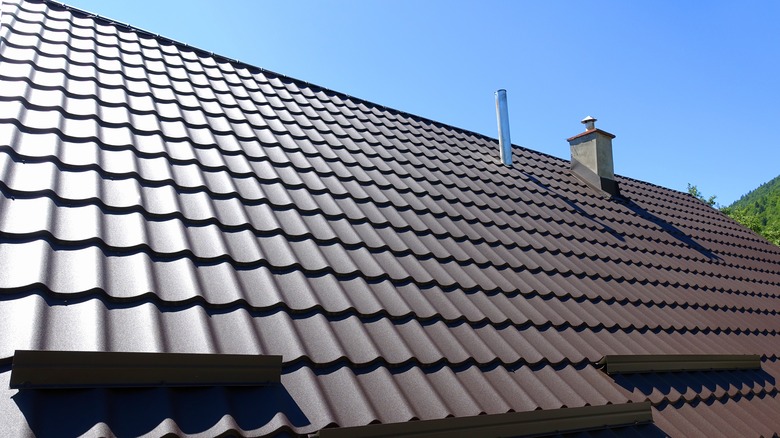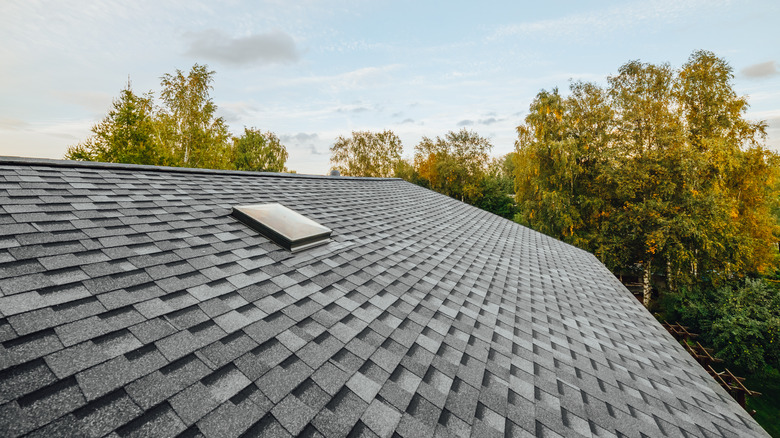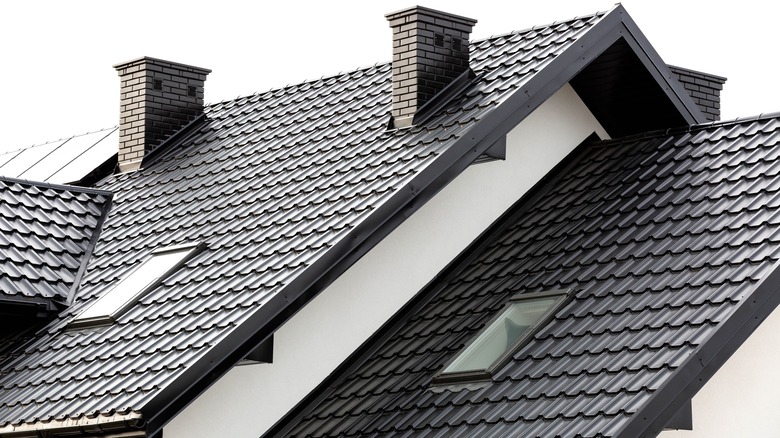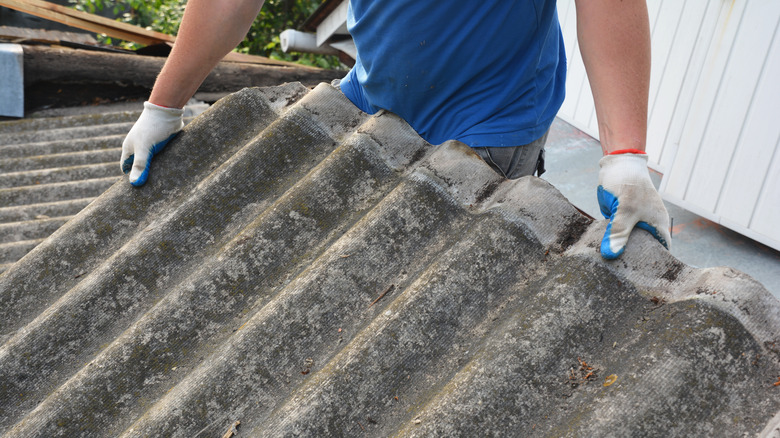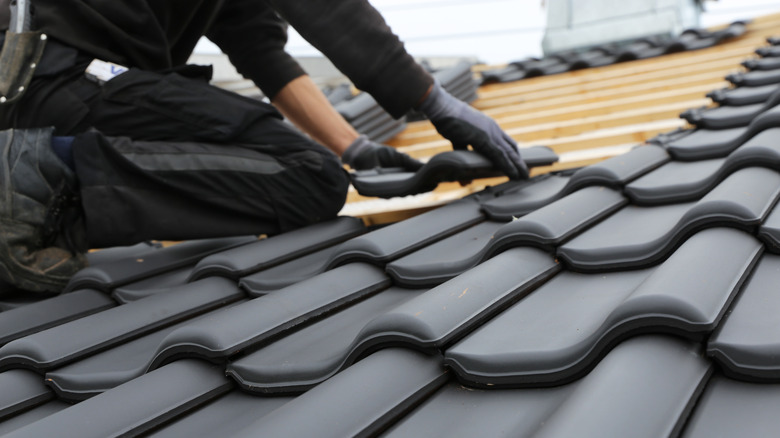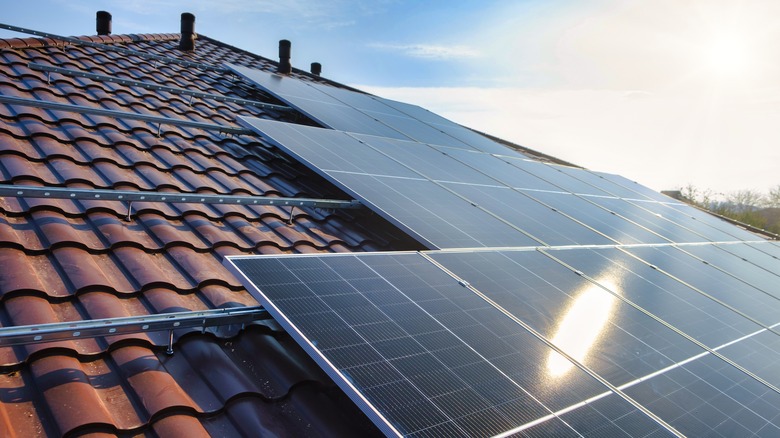Will Adding A New Roof Increase The Value Of Your Home?
Adding a new roof to a home is always a big task. These are expensive renovations, averaging about $8,000 and typically between $5,500 and $11,000, via Forbes Advisor. This means that a roof replacement might not be the first thing on your mind when you are preparing to sell a home or conduct other routine business on the property. While managing additional costs and financial goals, the expense can seem prohibitive and unwarranted. However, the value of a new roof goes a long way, often far exceeding the capital infused into the home through each shingle or tile fastened to the top of the property.
For one thing, if you're listing the house for sale, a new roof can be a major selling point: Drawing in additional interest from the market of potential buyers. A roof will typically last on the home without much issue for about 20 years, per Roof Advisor, and paired with a median figure of 13 years that a homeowner remains in any one home, via the National Association of Realtors, this is a fantastic bargain for most house hunters. The peace of mind in knowing that a roof likely won't demand this considerable expense during a standard tenure in the home makes buyers immensely interested. A home's added real and perceived value can drive up the price through competitive bidding that may quickly exceed your investment. For many reasons, a new roof can improve your home's value.
Competitive interest from buyers
Competition for a home on the market is always good for the seller and not so great for interested buyers. A new roof can spark increased interest in a property, creating a greater demand for the single real estate asset and building a sense of urgency among prospective bidders. Installing a new roof is an expensive proposition, but given the right market conditions, the National Association of the Remodeling Industry reports that a replacement can bring in a 109% return on investment.
Put simply, installing a new roof on your home in advance of a sale can pan out as a money-making investment rather than a financial drain. The reason is apparent: Home buyers won't have to invest their own cash in the roof unless they keep the home for decades and often pay a premium for this convenience. Likewise, a house with a new roof is a great acquisition opportunity for buyers looking to invest in the real estate market — rather than those interested in moving into the property themselves. An investor who doesn't have to add additional cash into the equation before the asset can begin generating income is a pleased one.
A roof boosts impressive standalone ROI figures
Even as a standalone investment in the home, a new roof can recoup nearly 70% of its investment, via IKO. Homeowners who need to replace their roofs might not be thrilled about the idea. Still, this renovation provides a wealth of benefits even as a significantly positive financial and comfort-related opportunity.
A home appraisal as a means to eliminate PMI insurance payments, for instance, can benefit immensely from the addition of a new roof. This change can add enough value to the property to substantially transform your effective equity share in the home's value. Likewise, adding a new roof to your home makes for a significant improvement to the living space beneath. In the event of a leak in the roof, the return on your investment comes in both financial terms and in the necessity of shoring up this weak point in the home that can lead to irreparable damages if left unchecked.
Old roofs certainly take away from a home's value
An old roof will add value to the property and reduce interest in your listed home by a massive factor. An old roof stands out like a sore thumb, and IKO reports that roof maintenance is a basic component of good home stewardship. Your roof will age with time, but a surface that appears much older than it actually is can signal trouble in the rest of the home. This reduces the interest and potential value of your property significantly.
Feldco Factory Direct suggests that a new roof can help you speed up the inspection process. In contrast, an older roof will require more extensive investigation and can even lead to a detrimental report that can tank a real estate transaction, lending decision, or other important deals. Old roofs can also create additional trouble in the home. From leaks and poor energy efficiency to infestation by pests, replacing the roof can give you the opportunity to remedy a number of issues you are seeing inside and above the home all at once, via First Star Exteriors Roofing and Siding.
Visual appeal is a key asset
Visual aspects of the home are important. A quality appearance makes a great first impression when listing a home for sale, and the same goes for hosting parties, inviting friends over for dinner or drinks, and more. IKO reports that the roof accounts for as much as 40% of a home's visual space and, as a result, plays a significant role in the curb appeal and overall visual layout of the property.
First Star Exteriors Roofing and Siding note that a new roof sets a home apart from neighboring properties. When listing a home for sale, a new roof can blow away a viewer and make the house a must-see rather than one that sparks potential interest. Replacing the roof gives you access to a brand new material on this overly visible section of the home that can draw significant attention. One of the primary facets of roof construction is that a new installation pops with color and visual appeal while an older one exists as a part of the home. The typical roof won't sway a potential buyer one way or another in many instances, but a roof that's falling apart or looks significantly older will turn buyers away. That said, a new roof will dramatically improve your interest level in the property.
Reductions in energy-related costs follow closely
In addition to boosted resale value, better curb appeal, and more, a new roof provides a fantastic platform for energy-efficient improvements to the property more broadly, via Feldco Factory Direct. Adding solar panels to your roof alongside a shingle or tile replacement can immediately amplify the benefit that the upper section of your home provides to the living space beneath. Bringing in new technology in the form of solar collection additions makes for a much more streamlined energy cost aspect within the home. Adding panels to offset your electricity needs can immediately reduce the amount you pay in heating and cooling bills, as well as the home's lighting and other electrical power needs.
Feldco Factory Direct also notes that new shingles or tiles on the roof can reduce the heated or cooled air loss that happens through the top of the home. As a result, a new roof improves energy efficiency all on its own and lowers the outgoing expenses of your bills by a marked standard without substantial enhancements beyond the typical roof replacement. Technology is constantly improving, and fabrication techniques have made for better quality roofing materials over the years. Considering that the current roof on your home may be 20 years old (or perhaps even older), it's easy to see why a replacement can bring a massive leap in technological efficiency.
